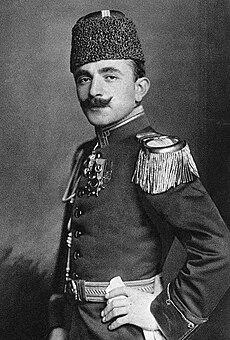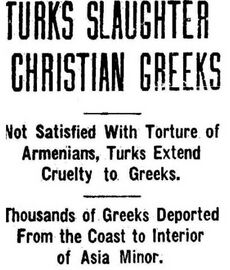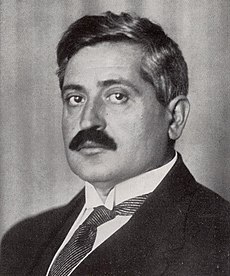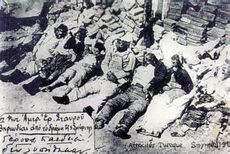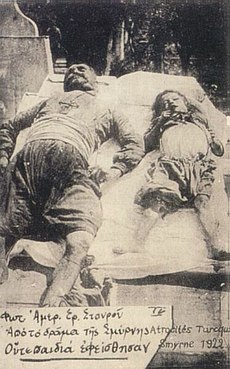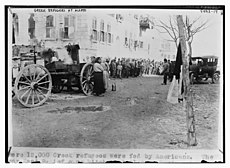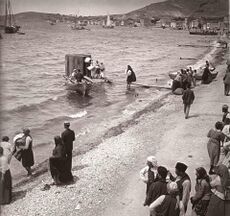Outline of the Greek genocide
Topic: History
 From HandWiki - Reading time: 20 min
From HandWiki - Reading time: 20 min
| Outline of the Greek genocide | |
|---|---|
| Part of World War I, the Aftermath of World War I, and the Armenian genocide | |
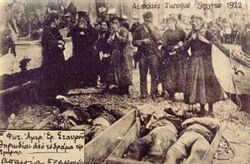 Greek civilians mourn their dead relatives, Great Fire of Smyrna, 1922 | |
| Location | Ottoman Empire |
| Date | 1913–1923 |
| Target | Ottoman Greeks |
Attack type | Deportation, mass murder, death march |
| Deaths | 300,000–900,000[1] |
| Perpetrators | Ottoman Empire, Turkish National Movement |
| Motive | Anti-Greek sentiment, Turkification, Persecution of Eastern Orthodox Christians |
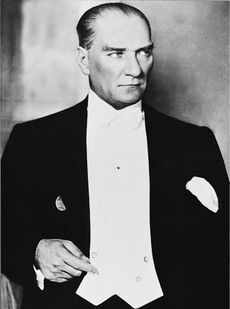
Below is an outline of Wikipedia articles related to the Greek genocide and closely associated events[lower-alpha 1] and explanatory articles.[lower-alpha 2] The topical outline is accompanied by a chronological outline of events. References are provided for background and overview.
The Greek Genocide was the mass killings and deportations of Greeks in the Ottoman Empire by Turkish forces. It resulted in the deaths of hundreds of thousands of Greeks, including the extermination of Pontian and Anatolian Greeks, the destruction of Smyrna, and widespread ethnic cleansing in Greek areas of Asia Minor.[3]
The Greek and Armenian Genocides are considered part of the more extensive period of mass killings and ethnic cleansing of Christian populations in the Ottoman Empire at the beginning of the 20th century. Both genocides were carried out by the Ottoman government and Turkish nationalist forces and involved mass killings, forced deportations, and population transfers. The events have been recognized as a genocide by numerous countries but have not been officially recognized by the Turkish government.[4][5]
Overviews
- Greek genocide
- Late Ottoman genocides
- 1914 Greek deportations
- Occupation of Smyrna
- Turkish capture of Smyrna
- Population exchange between Greece and Turkey
- Prosecution of Ottoman war criminals after World War I
- Greco-Turkish War (1919–1922)
Lists
- List of massacres during the Greco-Turkish War (1919–1922)
- Chronology of the Turkish War of Independence
- List of high-ranking commanders of the Turkish War of Independence
Background
- Turkish people, Young Turk Revolution, Turkish War of Independence, Turkish nationalism
- Ottoman Greeks, Pontic Greeks, Greek refugees
- Eastern Orthodoxy
- World War I, Aftermath of World War I
- Armenian genocide, Ottoman Armenians
- Armistice of Mudros, Occupation of Constantinople
- Assyrian genocide, Assyrian Syriac Christians
- Great Famine of Mount Lebanon
- Late Ottoman genocides
- Partition of the Ottoman Empire, Abolition of the Ottoman sultanate, Dissolution of the Ottoman Empire, Abolition of the Caliphate
Chronological outline of events
Below is a chronological outline of events related to the Greek genocide. This is intended to provide historical context for the articles about the Greek genocide. References are provided for background and overview information; for more references, see individual articles.[6][7]
- 12-18 june 1914: The Massacre of Phocaea was a mass killing of the Greek population of the town of Phocaea (now Foça) in western Turkey, during the Greek Genocide. The massacre took place in June 1914, and was part of a larger pattern of violence and atrocities committed against the Greek population in Anatolia by Ottoman forces and Turkish nationalist groups before during and after World War I.
- 1916: The Samsun deportations were a series of forced migrations of the Greek population of the city of Samsun in northern Turkey, during the Greek Genocide. The deportations took place in 1916, as part of a larger campaign by the Ottoman government to deport and exterminate the Greek population in Anatolia.[16]
- November 1918: The Armistice of 11 November 1918 ends the fighting of World War I and sets the stage for the Paris Peace Conference.[17]
- 15 May 1919 – 11 October 1922: The Greco-Turkish War (1919–1922) begins, leading to the forced relocation and extermination of thousands of Greeks in Asia Minor.[18]
- 15–16 May 1919: The Greek landing at Smyrna was the arrival of Greek forces in the city of Smyrna[lower-alpha 3] in May 1919, during the aftermath of World War I. The landing was part of a larger military intervention by the Allies, including Greece, aimed at protecting the significant Greek minority in the region and ensuring stability in the aftermath of the war. The intervention was controversial and led to conflict with the Turkish National Movement, which was fighting for independence and establishing a new Turkish state. The events in Smyrna and surrounding areas were contemporary with the outbreak of the Greco-Turkish War.[19][20]
- May–June 1919: The İzmit massacres were a series of violent attacks that took place in the city of İzmit in northwestern Turkey during the Greek genocide. The massacres occurred in May and June of 1919 and targeted the Greek community in the city, resulting in widespread violence and loss of life.[21] An Inter-Allied Commission of Enquiry that investigated the incidents in the region generally accepted the claims by Greek authorities that 32 villages had been looted or burned, and that more than 12,000 local civilians had been massacred by Turkish forces, and 2,500 were missing.[22]
- 1919-1920: The Istanbul trials of 1919–1920 were a series of military tribunals held in Istanbul (then Constantinople), Turkey, following the end of World War I. The trials were aimed at punishing Ottoman government officials and military leaders for their role in the mass extermination and forced migrations of the Armenian, Greek, and Assyrian populations in Anatolia during and after the war. The trials were organized by the Allies, who had defeated the Ottoman Empire in World War I. They were held in response to the widespread and systematic atrocities committed against minority communities in Anatolia, including the Armenian Genocide and the Greek Genocide.[25][26]
- October 1919 - January 1920: The Amasya trials were a series of military tribunals held in the city of Amasya, Turkey, in the aftermath of World War I. The trials were held between October 1919 and January 1920, and aimed to prosecute Ottoman officials who were accused of committing war crimes and crimes against humanity during the war and its aftermath. The trials were held in response to widespread reports of violence and atrocities committed against ethnic and religious minorities, including Armenians, Greeks, and Assyrians, during the war and in the years following the collapse of the Ottoman Empire.[25][26]
- May 1922: Evacuation of Ayvalik was a forced deportation of Greek residents from the town of Ayvalik in northwestern Turkey. The evacuation took place in May 1922, as part of a larger effort by the Ottoman government to expel the Greek population from Anatolia and erase their cultural heritage.[29][30]
- 5–8 September 1922: The Fire of Manisa refers to the burning of the town of Manisa, Turkey, which started on the night of Tuesday, 5 September 1922 and continued until 8 September. The fire was started by the retreating Greek Army during the Greco-Turkish War, and as a result, 90 percent of the buildings in the town were destroyed.[31][32]
- 9 September 1922: Turkish capture and occupation of Smyrna[33]
- 13–22 September 1922: Burning of Smyrna. The city of Smyrna (now İzmir) in western Turkey was the site of one of the largest and most violent massacres of the Greek Genocide. The city, which had a predominantly Greek and Armenian population, was set ablaze by Turkish military forces after a week-long siege, resulting in widespread destruction and loss of life.[34][35][33]
- 11 October 1922:[lower-alpha 4] The Armistice of Mudanya effectively ends the Greco-Turkish War (1919–1922).[17]
- 1 November 1922 : The Ottoman Empire is dissolved by the Grand National Assembly of Turkey and the modern Turkish state is established. Mustafa Kemal Atatürk becomes the first president of Turkey.[17]
- July 1923: The Treaty of Lausanne between the successor powers in the Ottoman Empire and the Allies of World War I is signed on 24 July 1923 and ratified in Turkey on 23 August 1923. The Republic of Turkey was formally declared on 29 October 1923. The treaty defined the borders of the new Turkish state and settled various territorial and financial disputes between the Ottoman Empire and the Allies. The treaty effectively ended the Ottoman Empire and provided a path for the establishment of the modern nation-state of Turkey. One of the most significant provisions of the treaty was the compulsory population exchange between Greece and Turkey, which resulted in the forced relocation of over 1 million Greeks from Anatolia to Greece and over 400,000 Turks from Greece to Turkey. The population exchange was intended to resolve the ethnic tensions that had arisen during and after World War I, and to create homogeneous nation-states in Greece and Turkey. The Treaty of Lausanne was signed by representatives of the government of Turkey and the Allies (Great Britain, France, Italy, and Japan).[36]
Individuals
- List of high-ranking commanders of the Turkish War of Independence
- Ambrosios Pleianthidis
- Asa Jennings
- Çetes
- Chrysostomos of Smyrna
- Djemal Pasha
- Doctor Nazım
- Euthymios (Agritellis)
- Félix Sartiaux
- Gregory (Orologas)
- Ismail Enver
- Matthaios Kofidis
- Mustafa Kemal Atatürk
- Nikolaos Tsourouktsoglou
- Nikos Kapetanidis
- Nureddin Pasha
- Otto Liman von Sanders
- Prokopios Lazaridis
- Talaat Pasha
- Theobald von Bethmann Hollweg
- Topal Osman
Entities
- Anatolia College in Merzifon
- Asia Minor Defense Organization
- Government of the Grand National Assembly
- Greek Caucasus Division
- Kuva-yi Milliye
- Labour Battalions (Turkey)
- Ottoman Empire
- Relief Committee for Greeks of Asia Minor
- Republic of Turkey
- Special Organization (Ottoman Empire)
- Three Pashas
Locations
- Anatolia
- Cunda Island
- East Thrace
- Edremit, Balıkesir
- Foça
- Gallipoli
- İzmit
- Kayaköy
- Smyrna
- Syrian Desert
- Turkey
- Western Thrace
- Yenifoça
Documents and agreements
- Convention Concerning the Exchange of Greek and Turkish Populations
Works about
- Not Even My Name
- Number 31328
- On the Quai at Smyrna
- Pontos (film)
- The Thirty-Year Genocide
- 1922 (1978 film)
- Smyrna my Beloved
Bibliography
Works listed provide information about the Greek genocide as well as context and background information.
Books
- Some works below contain annotations to academic journal reviews.
- Ahmad, F. (2014). The Young Turks and the Ottoman Nationalities: Armenians, Greeks, Albanians, Jews, and Arabs, 1908–1918. University of Utah Press.[37][38]
- Akçam, T. (2015). The Young Turks' Crime against Humanity: The Armenian Genocide and Ethnic Cleansing in the Ottoman Empire. Princeton: Princeton University Press.[39][40][41][42][43]
- Akçam, T., Kyriakidis, T., & Chatzikyriakidis, K. (Eds.). (2023). The Genocide of the Christian Populations in the Ottoman Empire and its Aftermath (1st edition). Routledge.[44]
- Butt, A. I. (2017). The Ottoman Empire’s Escalation from Reforms to the Armenian Genocide, 1908–1915. In Secession and Security: Explaining State Strategy against Separatists (pp. 125–162). Cornell University Press.
- Buttar, P. (2017). The Splintered Empires: The Eastern Front 1917–21. Osprey Publishing.
- Dobkin, M. H. (1998). Smyrna 1922: The Destruction of a City. New York, NY: Newmark Press.[45]
- Doukas, S. (1999). A Prisoner of War's Story. University of Birmingham, Institute of Archaeology & Antiquity Centre for Byzantine, Ottoman & Modern Greek Studies.
- Faltaits, K. (2016). The Genocide of the Greeks in Turkey: Survivor Testimonies from the Nicomedia (Izmit) Massacres of 1920–1921. Cosmos.
- Fotiadis, C. (Ed.). (2004). The Genocide of the Pontus Greeks. Herodotus.
- Fromkin, D. (2009). A Peace to End All Peace: The Fall of the Ottoman Empire and the Creation of the Modern Middle East (20th Anniversary edition). Holt.[46]
- Gaunt, D. (2006). Massacres, Resistance, Protectors: Muslim-Christian Relations in Eastern Anatolia during World War I. Gorgias Press.[47]
- Gingeras, R. (2016). Fall of the Sultanate: The Great War and the End of the Ottoman Empire 1908-1922 (Illustrated edition). Oxford University Press.[48][49]
- Halo, T. (2000). Not Even My Name. New York: Picador USA.
- Hinton, A. L., La Pointe, T., & Irvin-Erickson, D. (2013). Hidden Genocides: Power, Knowledge, Memory. Rutgers University Press.[50][51]
- Hofmann, T., Bjornlund, M., & Meichenetsidis, V. (Eds.). (2012). The Genocide of the Ottoman Greeks. Aristide Caratzas.
- Ihrig, S. (2014). Atatürk in the Nazi Imagination. Belknap Press.[52][53][54][55]
- Kieser, H. L. (2018). Talaat Pasha: Father of Modern Turkey, Architect of Genocide (Illustrated edition). Princeton University Press.[56][57][58]
- Kieser, H. L., Anderson, M. L., Bayraktar, S., & Schmutz, T. (Eds.). (2019). The End of the Ottomans: The Genocide of 1915 and the Politics of Turkish Nationalism. I.B. Tauris.
- Kontogeorge-Kostos, S. (2010). Before the Silence: Archival News Reports of the Christian Holocaust the Begs to be Remembered. Gorgias Press.
- Lewis, B. (1961). The Making of Modern Turkey. London: Oxford University Press.
- Llewellyn Smith, M. (1973). Ionian Vision: Greece in Asia Minor, 1919–1922. London: Allen Lane.[59][60][61][62]
- Matossian, B. D. (2022). The Horrors of Adana: Revolution and Violence in the Early Twentieth Century. Stanford University Press.
- Midlarsky, M. I. (2005). The Killing Trap. Cambridge: Cambridge University Press.[63]
- Milton, G. (2009). Paradise Lost: Smyrna 1922. The Destruction of Islam's City of Tolerance. Sceptre.
- Morris, B., & Ze’evi, D. (2019). The Thirty-Year Genocide: Turkey’s Destruction of Its Christian Minorities, 1894–1924. Harvard University Press.[64]
- Moses, A. D., Joeden-Forgey, E. von, Feierstein, D., Frieze, D.-L., Nunpa, M., Richmond, W., Jones, A., Hinton, P. A. L., Travis, H., & Hegburg, K. (2013). Hidden Genocides: Power, Knowledge, Memory (A. L. Hinton, T. L. Pointe, & D. Irvin-Erickson, Eds.). Rutgers University Press.[50][51]
- Murray, A. D. (2014). Black Sea: A Naval Officer's Near East Experience. (R. Heideman, Ed.). Kindle Digital.
- Payk, M. M., & Pergher, R. (Eds.). (2019). Beyond Versailles: Sovereignty, Legitimacy, and the Formation of New Polities after the Great War. Indiana University Press.
- Pranger, R. J. (2012). The Asia Minor Catastrophe and the Ottoman Greek Genocide: Essays on Asia Minor, Pontos, and Eastern Thrace, 1912-1923 (G. N. Shirinian, Ed.). Asia Monor and Pontos Hellenic Research Center.
- Rogan, E. (2015). The Fall of the Ottomans: The Great War in the Middle East. Basic Books.[65][66]
- Rummel, R. J. (1997). Death by Government. Transaction Publishers.[67][68]
- Sartiaux, F. (2008). Phocaea 1913–1920. The account of Félix Sartiaux. Rizario Idrima.
- Schaller, D. J., & Zimmerer, J. (Eds.). (2009). Late Ottoman Genocides: The dissolution of the Ottoman Empire and Young Turkish population and extermination policies (1st edition). Routledge.
- Shaw, S. J., & Shaw, E. K. (1977). History of the Ottoman Empire and Modern Turkey. Cambridge: Cambridge University Press.
- Shenk, R. (Ed.). (2012). America's Black Sea Fleet. Naval Institute Press.[69][70]
- Shenk, R., & Koktzoglou, S. (Eds.). (2020). The Greek Genocide in American Naval War Diaries. University of New Orleans Press.
- Shirinian, G. N. (Ed.). (2012). The Asia Minor Catastrophe and the Ottoman Greek Genocide. Asia Minor and Pontos Hellenic Research Center.
- Shirinian, G. N. (Ed.). (2017). Genocide in the Ottoman Empire: Armenians, Assyrians, and Greeks, 1913-1923. Berghahn Books.[71][72]
- Shirinian, G. N. (Ed.). (2019). The Greek Genocide 1913-1923: New Perspectives. The Asia Minor and Pontos Hellenic Research Center.
- Sjöberg, E. (2016). The Making of the Greek Genocide: Contested Memories of the Ottoman Greek Catastrophe. Berghahn Books.[73][74]
- Solomonidis, V. (2010). Greece in Asia Minor, 1919–1922. C. Hurst and Co. Publishers.
- Soteriou, D. (1991). Farewell Anatolia. (F. A. Reed, Trans.). Athens: Kedros.
- Starvridis, J. (2021). The Greek Genocide in American Naval War Diaries: Naval Commanders Report and Protest Death Marches and Massacres in Turkey’s Pontus Region, 1921-1922 (S. Koktzoglou & R. Shenk, Eds.). University of New Orleans Press.
- Suny, R. G., Gocek, F. M., & Naimark, N. M. (Eds.). (2011). A Question of Genocide: Armenians and Turks at the End of the Ottoman Empire. Oxford University Press.[75][76][77][78]
- Travis, H. (2010). Genocide in the Middle East: The Ottoman Empire, Iraq and Sudan. Carolina Academic Press.[79][80]
- Tsirkinidis, H. (1999). At Last We Uprooted Them: The Genocide of Greeks of Pontos, Thrace, and Asia Minor, through the French Archives. Thessaloniki: Kyriakidis Bros.
- Tsoukalas, C. (1969). The Greek Tragedy. New York: Penguin.
- Tusan, M. (2012). Smyrna's Ashes: Humanitarianism, Genocide and the Birth of the Middle East. University of California Press.[81][82][83]
- Ungor, U. U. (2012). The Making of Modern Turkey: Nation and State in Eastern Anatolia, 1913-1950. Oxford University Press.[84][85]
- Ureneck, L. (2015). The Great Fire: One American's mission to rescue victims of the Twentieth century's first Genocide. Ecco.
- Yeghiayan, V. (2007). British reports on Ethnic Cleansing in Anatolia 1919-1922: The Armenian-Greek Section. Center for Armenian Remembrance.
- Zürcher, E. J. (2010). The Young Turk Legacy and Nation Building: From the Ottoman Empire to Atatürk’s Turkey. I.B.Tauris.[86][87]
Journal articles
- Arango, T. (2015, April 16). A Century After Armenian Genocide, Turkey’s Denial Only Deepens. The New York Times.
- Aktar, A. (2007). Debating the Armenian Massacres in the Last Ottoman Parliament, November - December 1918. History Workshop Journal, 64, 240–270.
- Dadrian, V. N. (1994). The Documentation of the World War I Armenian Massacres in the Proceedings of the Turkish Military Tribunal. Journal of Political & Military Sociology, 22(1), 97–131.
- Gerwarth, R., & Üngör, U. Ü. (2015). The Collapse of the Ottoman and Habsburg Empires and the Brutalisation of the Successor States. Journal of Modern European History, 13(2), 226–248.
- Hofmann, T. (2015). The Genocide against the Ottoman Armenians: German Diplomatic Correspondence and Eyewitness Testimonies. Genocide Studies International, 9(1), 22–60.
- Kaloudis, G. (2014). Ethnic Cleansing In Asia Minor And The Treaty Of Lausanne. International Journal on World Peace, 31(1), 59–88.
- Maksudyan, N. (2016). Agents or Pawns?: Nationalism and Ottoman Children during the Great War. Journal of the Ottoman and Turkish Studies Association, 3(1), 139–164.
- Meichanetsidis, V. Th. (2015). The Genocide of the Greeks of the Ottoman Empire, 1913–1923: A Comprehensive Overview. Genocide Studies International, 9(1), 104–173.
- Schaller, D. J., Zimmerer J. (2008) Late Ottoman genocides: the dissolution of the Ottoman Empire and Young Turkish population and extermination policies, Journal of Genocide Research, 10(1), 7–14.
- Şekeryan, A. (2017). Reactions of the Armenian Community to the Emergence of the Turkish National Movement (1919–20). Journal of the Ottoman and Turkish Studies Association, 4(2), 381–401.
- Shaw, S. J. (1998). Resettlement of Refugees in Anatolia, 1918-1923. Turkish Studies Association Bulletin, 22(1), 58–90.
- Smith, R. W. (2014). Genocide Denial and Prevention. Genocide Studies International, 8(1), 102–109.
- Smith, R. W. (2015). Introduction: The Ottoman Genocides of Armenians, Assyrians, and Greeks. Genocide Studies International, 9(1), 1–9.
- Travis, H. (2014). The United Nations and Genocide Prevention. Genocide Studies International, 8(2), 122–152.
- Üngör, U. Ü., & Lohr, E. (2014). Economic Nationalism, Confiscation, and Genocide: A Comparison of the Ottoman and Russian Empires during World War I. Journal of Modern European History, 12(4), 500–522.
- Üngör, U. Ü. (2012). Rethinking the Violence of Pacification: State Formation and Bandits in Turkey, 1914–1937. Comparative Studies in Society and History, 54(4), 746–769.
- Üngör, U. Ü. (2012). Orphans, Converts, and Prostitutes: Social Consequences of War and Persecution in the Ottoman Empire, 1914–1923. War in History, 19(2), 173–192.
Genocide denial and distortion
This section is for works about genocide denial and distortion; it is not for works that deny or distort the history of the Greek genocide.
- Smith, R. W. (2015). Introduction: The Ottoman Genocides of Armenians, Assyrians, and Greeks. Genocide Studies International, 9(1), 1–9.
Contemporary sources
Sources below are related to the Greek and wider Christian genocide
- Massacre of the Greeks in Turkey: Story of the Tragic Fate of Hundreds of Thousands of Christian Noncombatants in the Levant. (1919). Current History, 9(3), 549–552.
Academic journals
This section is for English language academic journals related to the subject area.
- Journal of Modern Greek Studies[lower-roman 1]
- The Journal of Hellenic Studies[lower-roman 2]
- Journal of the Ottoman and Turkish Studies Association[lower-roman 3]
- Turkish Studies[lower-roman 4]
- First World War Studies[lower-roman 5]
- Genocide Studies International[lower-roman 6]
- Genocide Studies and Prevention: An International Journal[lower-roman 7]
- Holocaust and Genocide Studies[lower-roman 8]
- Journal of Genocide Research[lower-roman 9]
See also
- Genocides in history (before World War I)
- List of genocides
- List of ethnic cleansing campaigns
- Dissolution of the Ottoman Empire
- History of the Ottoman Empire
- Ottoman Empire in World War I
- Outline of the Ottoman Empire
- Timeline of the Ottoman Empire
Related or similar events
- Armenian genocide
- Assyrian genocide
- Great Famine of Mount Lebanon
- Late Ottoman genocides
- Herero and Namaqua genocide
References
Notes
Citations
- ↑ Sjöberg, Erik (2016). The Making of the Greek Genocide: Contested Memories of the Ottoman Greek Catastrophe. Berghahn Books. p. 234. ISBN 978-1-78533-326-2. "Activists tend to inflate the overall total of Ottoman Greek deaths, from the cautious estimates between 300,000 to 700,000..."
- ↑ https://greek-genocide.net/index.php/overview/perpetrators/mustafa-kemal-atatuerk
- ↑ The Thirty-Year Genocide: Turkey's Destruction of Its Christian Minorities, 1894–1924. Harvard University Press. 2019.
- ↑ "The Making of the Greek Genocide: Contested Memories of the Ottoman Greek Catastrophe. By Eric Sjöberg. New York: Berghahn Books, 2017. 255 pp. Notes. Bibliography. Glossary.". Slavic Review (Cambridge University Press) 77 (2): 503–504. 2018. doi:10.1017/slr.2018.151. ISSN 0037-6779.
- ↑ Meichanetsidis, Vasileios Th (2015). "The Genocide of the Greeks of the Ottoman Empire, 1913–1923". Genocide Studies International 9 (1): 104–173. doi:10.3138/gsi.9.1.06.
- ↑ "Chapter 9: Turks and Greeks, 1919-1924". The Thirty-Year Genocide: Turkey's Destruction of Its Christian Minorities, 1894–1924. Harvard University Press. 2019.
- ↑ "They Can Live in the Desert but Nowhere Else": A History of the Armenian Genocide. Princeton University Press. 22 March 2015. pp. 211–213, 246–327.
- ↑ July 1914: Countdown to War. Basic Books. 2013.
- ↑ Guns Of August: The Drama of August 1914. Random House. 1962.
- ↑ The Ottoman Road to War in 1914: The Ottoman Empire and the First World War. Cambridge University Press. 2008.
- ↑ "Epilogue: 1914-1923". The Ottomans 1700-1923: An Empire Besieged. Routledge. 2021.
- ↑ "Chapter 6: A Policy of Genocide". The Thirty-Year Genocide: Turkey's Destruction of Its Christian Minorities, 1894–1924. Harvard University Press. 2019.
- ↑ The End of the Ottomans: The Genocide of 1915 and the Politics of Turkish Nationalism. I.B. Tauris. 2019.
- ↑ Victory at Gallipoli, 1915: The German-Ottoman Alliance in the First World War. Pen & Sword Military. 2020.
- ↑ The Thirty-Year Genocide: Turkey's Destruction of Its Christian Minorities, 1894–1924. Harvard University Press. 2019. pp. 213–288, 388.
- ↑ The Thirty-Year Genocide: Turkey's Destruction of Its Christian Minorities, 1894–1924. Harvard University Press. 2019. pp. 102–129, 149–153, 180–189, 255, 272–275, 302–310.
- ↑ 17.0 17.1 17.2 "Chapter: 1918". Crucible: The Long End of the Great War and the Birth of a New World, 1917-1924. PublicAffairs. 2019.
- ↑ "Chapters: 1919, 1920". Crucible: The Long End of the Great War and the Birth of a New World, 1917-1924. PublicAffairs. 2019.
- ↑ The Lights that Failed: European International History 1919-1933. Oxford University Press. 12 May 2005. pp. 254–386.
- ↑ The Turkish War of Independence: A Military History, 1919–1923. Praeger. 2021.
- ↑ The Genocide of the Greeks in Turkey: Survivor Testimonies From The Nicomedia (Izmit) Massacres of 1920-1921. Cosmos Publishing. 2016.
- ↑ Reports on Atrocities in the Districts of Yalova and Guemlek and in the Ismid Peninsula (Report). 1921. http://archive.org/details/reportsonatrocit00interich.
- ↑ Paris 1919: Six Months That Changed the World (1st ed.). Random House. 29 October 2002. ISBN 978-0-375-50826-4.
- ↑ The Lights that Failed: European International History 1919-1933 (1st ed.). Oxford University Press. 12 May 2005. ISBN 978-0-19-822114-2.
- ↑ 25.0 25.1 "The Ottoman State Special Military Tribunal for the Genocide of the Armenians". The Hidden Histories of War Crimes Trials. Oxford University Press. 2013. pp. 77–100. doi:10.1093/acprof:oso/9780199671144.003.0004. ISBN 978-0-19-967114-4. https://doi.org/10.1093/acprof:oso/9780199671144.003.0004.
- ↑ 26.0 26.1 Dadrian, Vahakn N. (1994). "The Documentation of the World War I Armenian Massacres in the Proceedings of the Turkish Military Tribunal". Journal of Political & Military Sociology 22 (1): 97–131.
- ↑ Gingeras, Ryan (2009). Sorrowful Shores:Violence, Ethnicity, and the End of the Ottoman Empire 1912-1923. Oxford University Press. p. 28. ISBN 9780191609794. https://books.google.com/books?id=6DF4dNEjenIC&pg=PA28.
- ↑ Toynbee, Arnold Joseph (1970). The Western Question in Greece and Turkey:A Study in the Contact of Civilizations. H. Fertig, originally: University of California. pp. 283–284. ISBN 9780865272095. https://books.google.com/books?id=gTkbAAAAIAAJ&q=This+plan+is+being+carried+out+by+Greek+and+Armenian+bands,+++which+appear+to+operate+under+Greek+instructions+and+sometimes+++even+with+the+assistance+of+detachments+of+regular+troops.
- ↑ Freely, John (2010) (in en). Children of Achilles: The Greeks in Asia Minor Since the Days of Troy. I.B. Tauris. pp. 205–206. ISBN 9781845119416. https://books.google.com/books?id=OGzRrs4KkRoC&pg=PA206.
- ↑ Korma, Eleni (2003). "Ιστορία, μνήμη και ταυτότητα των προσφύγων : λογοτεχνικές αφηγήσεις για τη μικρασιατική καταστροφή" (in el-GR). University of Thessaly. http://ir.lib.uth.gr/handle/11615/13364. Retrieved 6 May 2018.
- ↑ Emecen, Feridun Mustafa (2006). Tarihin içinde Manisa. Manisa Belediyesi. p. 6. ISBN 9789759550608.
- ↑ Freely, John (2010). Children of Achilles: The Greeks in Asia Minor Since the Days of Troy. I.B. Tauris. p. 212. ISBN 9781845119416. https://books.google.com/books?id=OGzRrs4KkRoC&pg=PA212.
- ↑ 33.0 33.1 Fires of Hatred: Ethnic Cleansing in Twentieth-Century Europe. Harvard University Press. 2001. ISBN 9780674003132. https://archive.org/details/firesofhatredeth00naim/page/46/mode/2up.
- ↑ "The Destruction of Symrna: An Armenian and Greek shared tragedy". Genocide in the Ottoman Empire: Armenians, Assyrians, and Greeks, 1913-1923. Berghahn Books. 2017.
- ↑ "Chapter 20: Smyrna". The Ottoman Endgame: War, Revolution, and the Making of the Modern Middle East, 1908-1923. Penguin Books. 2015.
- ↑ Shields, Sarah (2013). "The Greek-Turkish Population Exchange: Internationally Administered Ethnic Cleansing". Middle East Report (267): 2–6.
- ↑ Rey, Matthieu (2016). "Reviewed work: The Young Turks and the Ottoman Nationalities : Armenians, Greeks, Albanians, Jews and Arabs, 1908-1918, Ahmad Feroz". Vingtième Siècle. Revue d'Histoire (129): 226–227.
- ↑ Hanioǧlu, M. Şükrü (2015). "Reviewed work: The Young Turks and the Ottoman Nationalities: Armenians, Greeks, Albanians, Jews, and Arabs, 1908-1918, Feroz Ahmad". International Journal of Middle East Studies 47 (3): 614–616. doi:10.1017/S0020743815000690.
- ↑ Üngör, Uğur Ümit (2012). "Reviewed work: The Young Turks' Crime against Humanity: The Armenian Genocide and Ethnic Cleansing in the Ottoman Empire, Taner Akçam". The American Historical Review 117 (5): 1703–1704. doi:10.1093/ahr/117.5.1703.
- ↑ Schull, Kent F. (2014). "The Young Turks' Crime against Humanity: The Armenian Genocide and Ethnic Cleansing in the Ottoman Empire. By Taner Akçam. Human Rights and Crimes against Humanity. Edited by Eric D. Weitz.Princeton, NJ: Princeton University Press, 2012". The Journal of Modern History 86 (4): 974–976. doi:10.1086/678755.
- ↑ Adalian, Rouben Paul (2015). "Reviewed work: The Young Turks' Crime against Humanity: The Armenian Genocide and Ethnic Cleansing in the Ottoman Empire, Taner Akçam". Genocide Studies International 9 (1): 174–178. doi:10.1353/gsp.2015.0004.
- ↑ Anderson, Margaret Lavinia; Reynolds, Michael; Kieser, Hans-Lukas; Balakian, Peter; Moses, A. Dirk; Akçam, Taner (2013). "Taner Akçam,The Young Turks' crime against humanity: The Armenian genocide and ethnic cleansing in the Ottoman Empire(Princeton, NJ: Princeton University Press, 2012)". Journal of Genocide Research 15 (4): 463–509. doi:10.1080/14623528.2013.856095.
- ↑ Klein, J. (2013). "The Young Turks' Crime against Humanity: The Armenian Genocide and Ethnic Cleansing in the Ottoman Empire". Journal of World History 24 (4): 908–913. doi:10.1353/jwh.2013.0111. ProQuest 1519577159. https://www.proquest.com/docview/1519577159.
- ↑ Akçam, Taner; Kyriakidis, Theodosios; Chatzikyriakidis, Kyriakos (2023). The Genocide of the Christian Populations in the Ottoman Empire and its Aftermath (1908-1923). Routledge. doi:10.4324/9781003207221. ISBN 978-1-00-320722-1.
- ↑ Wheeler, Geoffrey (1974). "Reviewed work: Smyrna 1922: The Destruction of a City, Marjorie Housepian". Journal of the Royal Asiatic Society of Great Britain and Ireland (1): 61–62. doi:10.1017/S0035869X0013151X.
- ↑ Karpat, Kemal H. (1991). "Reviewed work: A Peace to End All Peace: The Fall of the Ottoman Empire and the Creation of the Modern Middle East., David Fromkin". The Journal of Military History 55 (4): 546–547. doi:10.2307/1985781. http://www.gbv.de/dms/bowker/toc/9780805088090.pdf.
- ↑ Masters, Bruce (2008). "Reviewed work: Massacres, Resistance, Protectors: Muslim-Christian Relations in Eastern Anatolia during World War I, David Gaunt". Journal of the Economic and Social History of the Orient 51 (2): 390–393. doi:10.1163/156852008X307483.
- ↑ Ginio, Eyal; Gingeras, Ryan (2018). "Reviewed work: Fall of the Sultanate: The Great War and the End of the Ottoman Empire, GingerasRyan". War in History 25 (2): 281–283. doi:10.1177/0968344518760407b.
- ↑ Aksakal, Mustafa; Gingeras, Ryan (2017). "Reviewed work: Fall of the Sultanate: The Great War and the End of the Ottoman Empire, 1908–1922. (The Greater War.), GingerasRyan". The American Historical Review 122 (3): 961–962. doi:10.1093/ahr/122.3.961.
- ↑ 50.0 50.1 Beachler, Donald W. (2015). "Reviewed work: Hidden Genocides: Power, Knowledge, Memory, Alexander Laban Hinton, Thomas la Pointe, Douglas Irvin-Erickson". Genocide Studies International 9 (2): 269–271. doi:10.3138/gsi.9.2.07.
- ↑ 51.0 51.1 Heying, Shirley (2014). "Reviewed work: Hidden Genocides: Power, Knowledge, Memory, Alexander Laban Hinton, Thomas la Pointe, Douglas Irvin-Erickson". Journal of Anthropological Research 70 (4): 620–621.
- ↑ Tuğtan, Mehmet Ali (2016). "Atatürk in the Nazi Imagination". Bustan: The Middle East Book Review 7 (2): 162–168. doi:10.5325/bustan.7.2.0162.
- ↑ Brian Jk Miller (2016). "Review: Atatürk in the Nazi Imagination". Journal of the Ottoman and Turkish Studies Association 3 (2): 383. doi:10.2979/jottturstuass.3.2.12.
- ↑ Baer, Marc David (2016). "Reviewed work: Atatürk in the Nazi Imagination, Stefan Ihrig". The American Historical Review 121 (1): 326–327. doi:10.1093/ahr/121.1.326.
- ↑ Anderson, Margaret Lavinia (2016). "Reviewed work: Atatürk in the Nazi Imagination, Stefan Ihrig". Central European History 49 (1): 138–139. doi:10.1017/S0008938916000236. https://escholarship.org/uc/item/4qt900k7.
- ↑ Melson, Robert (2018). "Reviewed work: Talaat Pasha: Father of Modern Turkey, Architect of Genocide, Hans-Lukas Kieser". Genocide Studies International 12 (2): 253–256. doi:10.3138/gsi.12.2.08.
- ↑ Türesay, Özgür (2019). "Reviewed work: Talaat Pasha. Father of Modern Turkey, Architect of Genocide, Hans-Lukas Kieser". Studia Islamica 114 (1): 83–89. doi:10.1163/19585705-12341392.
- ↑ Badem (2019). "Reviewed work: Talaat Pasha: Father of Modern Turkey, Architect of Genocide, Hans-Lukas Kieser". Journal of the Ottoman and Turkish Studies Association 6 (1): 237–239. doi:10.2979/jottturstuass.6.1.13.
- ↑ Dakin, D. (1978). "Reviewed work: Ionian Vision: Greece in Asia Minor 1919-1922, Michael Llewellyn Smith". Middle Eastern Studies 14 (1): 133–136.
- ↑ Howard, Harry N. (1974). "Reviewed work: Ionian Vision: Greece in Asia Minor, 1919-1922, Michael Llewellyn Smith". Middle East Journal 28 (3): 352–353.
- ↑ Hopwood, Derek (1975). "Reviewed work: Ionian Vision. Greece in Asia Minor 1919-1922, Michael Llewellyn Smith". The English Historical Review 90 (356): 685–686. doi:10.1093/ehr/XC.CCCLVI.685.
- ↑ Matthews, K. (1974). "Reviewed work: Ionian Vision. Greece in Asia Minor 1919-1922., Michael Llewellyn Smith; the Lions of Marash. Personal Experiences with American Near East Relief. 1919-1922., Stanley e. Kerr". International Affairs 50 (2): 307–308. doi:10.2307/2616723.
- ↑ Spector, R. M. (2006). "MANUS I. MIDLARSKY. The Killing Trap: Genocide in the Twentieth Century. New York: Cambridge University Press. 2005. Pp. Xv, 463. Cloth $75.00, paper $28.99". The American Historical Review 111 (3): 805–806. doi:10.1086/ahr.111.3.805.
- ↑ Mehigan, James (2020). "Reviewed work: The Thirty Year Genocide: Turkey's Destruction of its Christian Minorities 1894–1924, B. Morris, D. Ze'evi". State Crime Journal 9 (1): 142–145. doi:10.13169/statecrime.9.1.0142.
- ↑ Reynolds, Michael A. (2015). "Reviewed work: The Fall of the Ottomans: The Great War in the Middle East, Eugene Rogan". Middle East Journal 69 (3): 491–492.
- ↑ Yanikdaǧ, Yücel (2016). "Reviewed work: The Fall of the Ottomans: The Great War in the Middle East, Eugene Rogan". International Journal of Middle East Studies 48 (2): 403–405. doi:10.1017/S0020743816000234.
- ↑ Harff, Barbara (1996). "Reviewed work: Death by Government, R. J. Rummel". The Journal of Interdisciplinary History 27 (1): 117–119. doi:10.2307/206491.
- ↑ Freeman, Michael (1996). "Reviewed work: Death by Government, R. J. Rummel". The Slavonic and East European Review 74 (3): 591–592.
- ↑ Morgan-Owen, David (2015). "Reviewed work: America's Black Sea Fleet: The U.S. Navy Amidst War and Revolution, 1919–1923, Robert Shenk". The International History Review 37 (3): 648–649. doi:10.1080/07075332.2015.1035423.
- ↑ Millea, Nick (2009). "Bibliography". Imago Mundi 61 (1): 128–143. doi:10.1080/03085690802456350.
- ↑ Bjørnlund, Matthias (2018). "Reviewed work: Genocide in the Ottoman Empire: Armenians, Assyrians, and Greeks, 1913-1923, George N. Shirinian". Genocide Studies International 12 (1): 129–146. doi:10.3138/gsi.12.1.10.
- ↑ Göçek, Fatma Muge (2018). "Reviewed work: Genocide in the Ottoman Empire: Armenians, Assyrians and Greeks, 1913–1923, George N. Shirinian". Slavic Review 77 (4): 1054–1056. doi:10.1017/slr.2018.306.
- ↑ Üngör, Uğur Ümit; Sjöberg, Erik (2017). "Reviewed work: The Making of the Greek Genocide: Contested Memories of the Ottoman Greek Catastrophe. (War and Genocide 23.), SjöbergErik". The Hungarian Historical Review 6 (1): 247–249.
- ↑ Akçam, Taner; Sjöberg, Eric (2018). "Reviewed work: The Making of the Greek Genocide: Contested Memories of the Ottoman Greek Catastrophe, SjöbergEric". Slavic Review 77 (2): 503–504. doi:10.1017/slr.2018.151.
- ↑ Usitalo, Steven A. (2012). "Reviewed work: A Question of Genocide: Armenians and Turks at the End of the Ottoman Empire, Ronald Grigor Suny, Fatma Müge Göçek, Norman M. Naimark". Canadian Slavonic Papers / Revue Canadienne des Slavistes 54 (3/4): 557–558.
- ↑ Eissenstat, Howard (2012). "Reviewed work: A Question of Genocide: Armenians and Turks at the End of the Ottoman Empire, Ronald Grigor Suny, Fatma Müge Göçek, Norman M. Naimark". International Journal of Middle East Studies 44 (3): 584–586. doi:10.1017/S002074381200061X.
- ↑ Gingeras, Ryan (2012). "Reviewed work: A Question of Genocide: Armenians and Turks at the End of the Ottoman Empire, Ronald Grigor Suny, Fatma Müge Göçek, Norman M. Naimark". The English Historical Review 127 (529): 1570–1572. doi:10.1093/ehr/ces294.
- ↑ Gunter, Michael M. (2012). "Reviewed work: A Question of Genocide: Armenians and Turks at the End of the Ottoman Empire, RONALD GRIGOR SUNY, FATMA MÜGE GÖÇEK, NORMAN M. NAIMARK". Journal of World History 23 (2): 456–459. doi:10.1353/jwh.2012.0033.
- ↑ Welton, Mark C. (2010). "Reviewed work: Genocide in the Middle East: The Ottoman Empire, Iraq, and Sudan, Hannibal Travis". Middle East Journal 64 (4): 674–675.
- ↑ Aslan, Senem (2011). "Reviewed work: Genocide in the Middle East: The Ottoman Empire, Iraq, and Sudan, Hannibal Travis". International Journal of Middle East Studies 43 (2): 335–336. doi:10.1017/S0020743811000171.
- ↑ Proctor (2015). "Journal Review: Atatürk in the Nazi Imagination". Victorian Studies 57 (4): 754. doi:10.2979/victorianstudies.57.4.32.
- ↑ Rodogno, Davide (2014). "Smyrna's Ashes: Humanitarianism, Genocide, and the Birth of the Middle East. By Michelle Tusan. Berkeley Series in British Studies, number 5. Edited by Mark Bevir and James Vernon.Berkeley: University of California Press, 2012. Pp. Xiv+254. $34.95 (Paper)". The Journal of Modern History 86 (3): 673–675. doi:10.1086/676710.
- ↑ Midlarsky, Manus I. (2014). "Reviewed work: Smyrna's Ashes: Humanitarianism, Genocide, and the Birth of the Middle East. (The Berkeley Series in British Studies, number 5.), Michelle Tusan". The American Historical Review 119 (1): 284–285. doi:10.1093/ahr/119.1.284.
- ↑ Thörne, Annika (2012). "Reviewed work: The Making of Modern Turkey. Nation and State in Eastern Anatolia, Uğur Ümit Üngör". Iran & the Caucasus 16 (3): 387–389. doi:10.1163/1573384X-20120027.
- ↑ Stone, Norman (2013). "Reviewed work: The Making of Modern Turkey: Nation and State in Eastern Anatolia 1913—1950, Uǧur Ümit Üngör". The English Historical Review 128 (530): 198–199. doi:10.1093/ehr/ces374.
- ↑ Meeker, Michael E. (2011). "Reviewed work: The Young Turk Legacy and Nation-Building: From the Ottoman Empire to Atatürk's Turkey, Erik J. Zürcher". Middle East Journal 65 (2): 344–345.
- ↑ Öktem, Kerem (2014). "Reviewed work: The Young Turk Legacy and Nation Building from the Ottoman Empire to Atatürk's Turkey, Erik Jan Zürcher". The English Historical Review 129 (537): 483–485. doi:10.1093/ehr/ceu067.
Academic journals
- ↑ Journal of Modern Greek Studies, https://muse.jhu.edu/journal/126
- ↑ "The Journal of Hellenic Studies", Nature 124 (3117): 121, 1929, doi:10.1038/124121a0, Bibcode: 1929Natur.124..121., https://www.cambridge.org/core/journals/journal-of-hellenic-studies
- ↑ Journal of the Ottoman and Turkish Studies Association, https://www.jstor.org/journal/jottturstuass
- ↑ Turkish Studies Journal at Taylor & Francis, https://www.tandfonline.com/journals/ftur20
- ↑ First World War Studies journal at Taylor & Francis, https://www.tandfonline.com/journals/rfww20
- ↑ Genocide Studies International at JSTOR, https://www.jstor.org/journal/genocidestudies
- ↑ Genocide Studies and Prevention at JSTOR, https://digitalcommons.usf.edu/gsp/
- ↑ Holocaust and Genocide Studies, https://academic.oup.com/hgs
- ↑ Journal of Genocide Research at Taylor & Francis, https://www.tandfonline.com/action/journalInformation?journalCode=cjgr20
External links
- Timeline of the Greek Genocide, Greek Genocide Resource Center.
- Overview of the Greek genocide, The Asia Minor and Pontos Hellenic Research Center
- Bibliography, The Greek Genocide Resource Center.
- The Greek Genocide, 1914-1923, Genocide Watch.
 |
 KSF
KSF